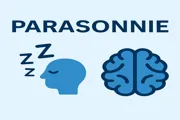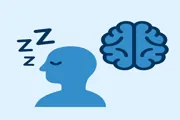Parasonnias are a set of disorders that occur during sleep and include unwanted experiences that involve movement, behavior, emotion, perception, or dreaming. These are not conscious or voluntary actions but rather spontaneous episodes that manifest at different stages of sleep. Often, individuals are unaware of them and have no memory of what occurred. These conditions are commonly associated with childhood but can persist or emerge in adulthood.
They are generally divided into categories based on the sleep phase in which they occur: non-REM (NREM), REM, or other transitional periods between wakefulness and sleep. Understanding the differences helps in identifying their origin and planning appropriate management strategies.
Parasonnias during the NREM phase
During the NREM stage, especially in the first few hours of sleep, the brain enters a deeper state of rest. This is the period in which certain motor phenomena can emerge, such as sitting up suddenly in bed, walking while asleep, or speaking incoherently. These episodes usually occur in children but can occasionally be observed in adults. They tend to reduce over time and may disappear entirely by adolescence or adulthood.
Duration of such events varies, typically lasting from a few seconds to up to thirty minutes. In these moments, the individual may appear awake but is actually in a transitional state between sleep and wakefulness. The root causes can vary but often include:
- Lack of sufficient sleep
- Irregular or interrupted sleep patterns
- Fever or illness, especially in children
- Psychological stress or emotional tension
- Use of alcohol or medications affecting the central nervous system
Memory and awareness during episodes
One of the notable features of NREM parasonnias is the lack of memory of the event. In most cases, the individual cannot recall what occurred. There are different types of manifestations that fall under this phase, including partial awakenings with disorientation, aggressive or defensive behavior, and more commonly, sleepwalking or confused speech. In children, episodes may involve waking up with signs of agitation—such as heavy breathing, sweating, and a pale complexion—without full awareness.
What science tells us
Current research has not yet produced a univocal explanation for parasonnias. The prevailing theory suggests that certain brain regions responsible for motor control become active while others that regulate awareness and memory remain dormant. This dissociation explains why individuals may perform actions without conscious control or later recollection.
Diagnostic process
Diagnosis is based primarily on detailed reporting from witnesses—often family members—who have observed the episodes. In more complex or risky cases, specialists may recommend advanced tests such as video-polysomnography, a technique that monitors the patient overnight to evaluate brain activity, oxygen levels, heart rate, and body movements.
In general, these episodes are benign. Education and reassurance for the individual and family are key. Pharmacological treatment is rarely necessary and is usually reserved for severe or dangerous cases where the behavior poses a risk to the patient or others.
Parasonnias during the REM phase
REM sleep is typically marked by minimal muscle activity and vivid dreaming. However, in certain individuals, this phase is interrupted by motor episodes where the sleeper physically reacts to dreams—often violently. Kicking, yelling, or flailing may occur, sometimes putting the bed partner at risk. These episodes are more common in men aged 60–70 and may be linked to underlying neurological conditions.
The events usually last from 3 to 10 minutes. People affected might recall their dreams vividly, and upon waking, feel confused or distressed. As in the NREM type, diagnosis is based on behavioral patterns and confirmed by polysomnography if needed.
Associated phenomena
Parasonnias encompass a wide array of behaviors, such as:
- Sleep paralysis : a transient inability to move when falling asleep or waking, often accompanied by hallucinations and intense anxiety.
- Night terrors : especially in children, these episodes involve sudden awakening with a scream, signs of panic, and no clear memory.
- Exploding head syndrome : a harmless but alarming sensation of a loud internal explosion just as the person is falling asleep.
- Hypnagogic hallucinations : vivid imagery at the transition from wakefulness to sleep, sometimes confused with dreams or delusions.
- Nocturnal enuresis : bedwetting episodes in children aged 5–6 that may be related to stress or sleep phase immaturity.
- Sleep-related eating disorder : involuntary eating during sleep, often with no memory the following morning.
Final considerations
Parasonnias are diverse in origin and manifestation. Although most are benign and tend to resolve with age or behavioral adjustments, some may require clinical attention. Ensuring sleep hygiene, minimizing stress, and maintaining a structured nighttime routine are basic steps toward prevention. Understanding these phenomena can help reduce fear, promote timely diagnosis, and offer peace of mind to those who experience or witness them.

